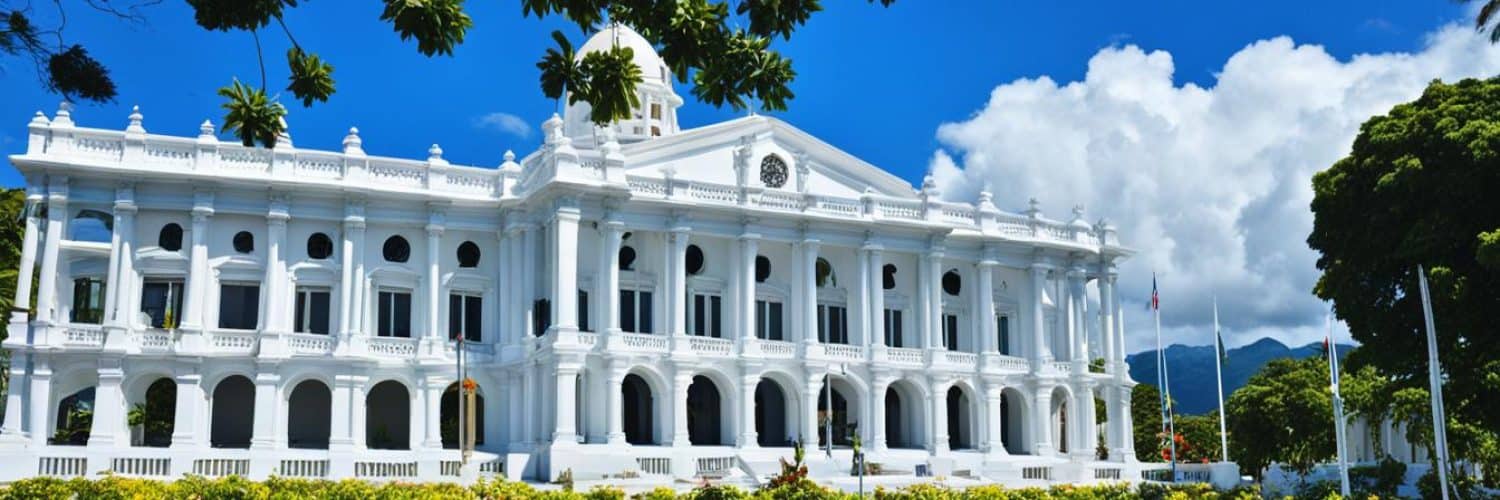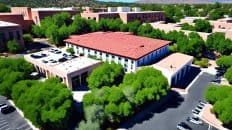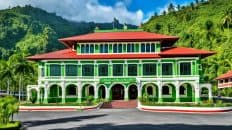Have you ever wondered what lies behind the doors of the Leyte Provincial Capitol? This iconic government building in Leyte Province holds a rich history and is filled with captivating stories waiting to be discovered. From surviving war and natural disasters to its unique architectural design, the Leyte Provincial Capitol is more than just a government building – it is a testament to the resilience and cultural heritage of the people of Leyte.
Join us on a virtual journey as we explore the Leyte Provincial Capitol, its fascinating history, stunning architectural features, and its significance as a symbol of resilience. Discover how this historical site has withstood the test of time and why it is a must-visit destination for any traveler exploring Leyte.
Key Takeaways:
- Learn about the rich history of the Leyte Provincial Capitol and its role in Philippine history.
- Discover the unique architectural design and features of the capitol building.
- Explore MacArthur Park, adjacent to the capitol, and its significance in World War II history.
- Understand the impact of General Douglas MacArthur and the controversies surrounding his actions.
- Appreciate the Leyte Provincial Capitol as a symbol of resilience and cultural heritage.
History of Leyte Provincial Capitol
The Leyte Provincial Capitol has a rich history that dates back to the American colonial administration in the Philippines. Construction of the building began in 1917 and was completed in 1924. For many years, it served as the seat of government for the province of Leyte, housing the offices of the Leyte Governor and other provincial officials.
During the World War II era, the Leyte Provincial Capitol played a significant role in Philippine history. In 1944, as the Allied forces liberated the Philippine islands from Japanese occupation, the capitol became the temporary national capitol. It was in this historic building that General Douglas MacArthur, the Allied forces’ supreme commander, conducted the swearing-in ceremony of Sergio Osmeña as the President of the Philippines.
Since its construction, the Leyte Provincial Capitol has undergone renovations to preserve its historical significance. In 1964, renovations and improvements were made to enhance the building’s structure and aesthetics. As a testament to its historical and architectural value, the Leyte Provincial Capitol has been declared a National Historical Landmark.
“The Leyte Provincial Capitol stands as a symbol of resilience and a testament to the enduring spirit of the people of Leyte.” – Leyte Preservation Society
The Leyte Provincial Capitol represents an important chapter in Philippine history, particularly during the World War II era. It serves as a reminder of the resilience and courage displayed by the people of Leyte during challenging times. The architectural beauty and historical significance of the building make it a must-visit destination for those interested in Philippine history and culture.
Key Events:
- Construction of the Leyte Provincial Capitol began in 1917 and was completed in 1924.
- The capitol became the temporary national capitol during the World War II era as the Allied forces liberated the Philippine islands.
- General Douglas MacArthur conducted the swearing-in ceremony of Sergio Osmeña as President of the Philippines in the capitol building.
- Renovations were carried out in 1964 to preserve the capitol’s historical significance.
- The Leyte Provincial Capitol has been declared a National Historical Landmark.
Architectural Design and Features
The Leyte Provincial Capitol is an iconic landmark that showcases a magnificent blend of neoclassical architecture and American influences. Its architectural design and features make it a standout among Leyte landmarks.
The main structure of the Leyte Provincial Capitol is characterized by a stunning white facade, exuding elegance and grandeur. Behind the main building, there is a legislative building that complements the overall design.
As you ascend the concrete steps leading to the entrance, you’ll be greeted by two 19th-century iron cannons on both sides, adding a touch of historical charm to the setting.
One of the most captivating aspects of the Leyte Provincial Capitol is the presence of impressive bas relief sculptures. Adorning the wings of the building, these intricate sculptures depict significant historical events in Leyte’s past. Notably, the first Christian Mass in Limawasa and General MacArthur’s historic landing on Red Beach are brought to life through these sculptures. The addition of these bas relief sculptures in 1964 further enhances the cultural and historical significance of the Capitol.
“The architectural design and features of the Leyte Provincial Capitol are a testament to the province’s vibrant history and cultural heritage. They serve as a visual representation of Leyte’s rich past and make the Capitol a true standout among the province’s landmarks.”
This grand structure stands proud as a symbol of Leyte’s historical legacy, enticing visitors with its striking design and captivating bas relief sculptures.
| Architectural Features | Description |
|---|---|
| Neoclassical Architecture | The Leyte Provincial Capitol showcases a neoclassical architectural style, combining elements from ancient Greek and Roman designs. |
| American Influence | The Capitol’s design reflects strong American influences, as it was constructed during the American occupation of the Philippines. |
| Bas Relief Sculptures | The wings of the Capitol feature exquisite bas relief sculptures depicting the first Christian Mass in Limawasa and General MacArthur’s landing on Red Beach. These intricate sculptures add depth and historical significance to the building. |
| Leyte Landmark | The Leyte Provincial Capitol stands as an iconic landmark in the province, representing its rich history and cultural heritage. |
The Leyte Provincial Capitol’s architectural design and features make it a must-visit attraction for those fascinated by history, culture, and stunning architectural marvels.
MacArthur Park and Memorial
Adjacent to the Leyte Provincial Capitol is MacArthur Park, a significant historical landmark in Leyte. The park commemorates General Douglas MacArthur’s landing in Leyte Gulf in 1944, a pivotal moment in World War II. MacArthur, along with his companions, played a crucial role in liberating the Philippines from Japanese occupation.
The centerpiece of MacArthur Park is a striking sculpture designed by Anastacio Caedo. It depicts General MacArthur and his fellow soldiers during their momentous landing. The sculpture stands as a powerful tribute to their courage and sacrifice.
“I have returned” – General Douglas MacArthur
The park also features seven bronze statues representing the men who accompanied MacArthur during the landing. These statues serve as a poignant reminder of the bravery and unity displayed during the World War II era.
Within MacArthur Park, there is a museum that houses war memorabilia and artifacts related to the Leyte landing. Visitors can explore the museum and gain a deeper understanding of the historical significance of MacArthur’s return.
One of the notable attractions in the park is a bronze cast of MacArthur’s footprints, symbolizing his lasting impact on Leyte and the Philippines as a whole.
Recognizing its historical importance, MacArthur Park was declared a national historical landmark in 1994. It stands as a testament to the valor and resilience displayed during World War II and remains a significant cultural icon in Leyte.
Damage and Renovation
The Leyte Provincial Capitol has faced various challenges throughout its history, including natural disasters and the need for repairs and renovations. One significant event that caused damage to the capitol was Typhoon Haiyan in 2013. The storm surges generated by the typhoon impacted the building, requiring restoration efforts to be undertaken.
Despite the repairs, the capitol sustained further damage in 2019 due to a magnitude 6.4 earthquake. The seismic activity caused structural problems, posing safety concerns for the building’s occupants. As a result, the provincial government made the decision to abandon the original capitol and pursue the construction of a new capitol in Palo.
This choice ensures the safety of government officials and employees while also preserving the historical significance of the original capitol building. The planned conversion of the old capitol into a museum will allow visitors to appreciate and learn from the building’s rich history, showcasing its resilience in the face of challenges.
It is an important step in maintaining Leyte’s cultural heritage and demonstrating the government’s commitment to preserving the past for future generations.
Despite the damage and the subsequent relocation of the Provincial Capitol, the spirit of resilience in Leyte continues to inspire. The Leyte government’s plans for a new capitol in Palo and the conversion of the old capitol into a museum showcase their commitment to preserving Leyte’s heritage and moving forward in the face of adversity.
Location and Accessibility
The Leyte Provincial Capitol is conveniently located at the corner of Senato Enage Street and Magsaysay Boulevard in Tacloban, Leyte. This historic government building is easily accessible and is surrounded by notable landmarks, making it a must-visit destination for travelers exploring Leyte.
Surrounding the Leyte Provincial Capitol are several prominent sites, including the Eastern Visayas Regional Medical Center and Plaza Liberta. These landmarks add to the allure of the capitol, providing visitors with more attractions to explore in the vicinity.
Getting to the Leyte Provincial Capitol is straightforward. Visitors can take a jeepney or multi-cab heading to St. Paul/Campetic from Tacloban and simply disembark at Campetic Crossing. From there, it is a short walk to the capitol building, allowing visitors to admire its architectural splendor and immerse themselves in Leyte’s history.
“Leyte Provincial Capitol is a must-visit destination for travelers exploring the cultural heritage of Leyte.”
Adjacent to the Leyte Provincial Capitol is MacArthur Park, where you can continue your journey through history. Located in Barangay Candahug, the park can be easily reached by pedicab from Campetic Crossing. MacArthur Park is a significant historical landmark commemorating General Douglas MacArthur’s landing in Leyte during World War II, offering visitors a poignant glimpse into Leyte’s past.
Overall, the Leyte Provincial Capitol’s central location and accessibility make it an ideal starting point for exploring Leyte’s landmarks and immersing yourself in the cultural richness of the province.
Best Time to Visit
The Leyte Provincial Capitol and MacArthur Park are open to the public daily, allowing visitors to plan their visit at any convenient time. Whether you’re a morning person or prefer the afternoon, you can explore these historical attractions at your leisure.
However, it’s always a good idea to check the weather conditions beforehand, as Leyte can experience tropical weather patterns. This will ensure that you can make the most of your visit and avoid any unexpected rainfall or extreme heat.
Visiting the Leyte Provincial Capitol and MacArthur Park is a perfect way to immerse yourself in Leyte’s rich history and cultural heritage. Whether you’re interested in the architecture, the memorial park, or simply want to learn more about Leyte’s past, these attractions offer a unique and enlightening experience.
| Benefits of visiting the Leyte Provincial Capitol and MacArthur Park | Tips for a great visit |
|---|---|
|
|
Exploring the Leyte Provincial Capitol and MacArthur Park is an enriching experience for history enthusiasts and travelers alike. Plan your visit today and embark on a journey through Leyte’s fascinating past!
Leyte Provincial Capitol as a Symbol of Resilience
The Leyte Provincial Capitol stands as a symbol of resilience for the people of Leyte. Despite facing various challenges and natural disasters throughout its history, the capitol has survived and continues to serve as a reminder of the province’s rich cultural heritage.
The Leyte Provincial Capitol, with its historic significance and architectural beauty, has withstood the test of time. From damages caused by the Japanese-American War to the destructive storm surges brought by Typhoon Haiyan in 2013, and even the devastating earthquake in 2019, the capitol remains standing as a testament to Leyte’s unwavering strength.
“The Leyte Provincial Capitol is not just a building; it is a symbol of our resilience as a province. It has witnessed significant historical events, and its preservation is our way of honoring our past and shaping our future.” – Leyte Governor
The decision to convert the capitol building into a museum speaks to the province’s commitment to preserving its history for future generations. By transforming the capitol into a cultural landmark, Leyte ensures that the stories and heritage of its people continue to be showcased and celebrated.
The Leyte Provincial Capitol serves as a reminder of the resilience and determination of the people of Leyte. It stands as a testament to their ability to rebuild and recover from adversity while preserving their cultural identity. Visiting the capitol offers a glimpse into the rich history and cultural heritage of Leyte, leaving visitors in awe of its strength and beauty.
Controversies and Impact of General Douglas MacArthur
General Douglas MacArthur played a significant role in Philippine history, especially during the liberation of Leyte in World War II. However, his actions have been the subject of controversies, both internationally and within his home state. Despite these controversies, MacArthur’s landing in Leyte remains an iconic moment in Philippine history, symbolizing the beginning of the country’s journey towards independence.
“I have returned!” – General Douglas MacArthur
MacArthur’s famous declaration upon his return to the Philippines resonates to this day, signifying the sacrifices made during World War II and the cultural significance of Leyte. The memorial dedicated to his landing serves as a powerful reminder of the bravery and resilience displayed during this pivotal time in history.
Controversies Surrounding MacArthur
General Douglas MacArthur’s leadership and decisions during World War II have been a topic of debate and scrutiny. One of the most significant controversies is his handling of the defense of the Philippines and his subsequent evacuations, leaving many Filipino and American soldiers behind.
Furthermore, MacArthur’s promise of “I shall return” created high expectations among the Filipino people, resulting in disappointment for some when the liberation did not immediately bring the desired outcomes. MacArthur’s egocentric reputation and strained relationship with other military leaders have also contributed to the controversies surrounding his time in the Philippines.
The Cultural Significance of Leyte
Leyte, with its historical connections to General Douglas MacArthur, holds immense cultural significance in the Philippines. MacArthur’s return and subsequent liberation of the country fostered a sense of hope, resilience, and determination among the Filipino people.
The events in Leyte during the war left a lasting impact on the region and the nation as a whole. The historical sites and monuments that commemorate MacArthur’s landing stand as reminders of the sacrifices made and the long journey towards independence and freedom.
| Controversies | Impact on Leyte |
|---|---|
| Debate over MacArthur’s leadership and decisions in the defense of the Philippines | Symbolic significance of MacArthur’s landing and liberation of Leyte |
| Disappointment over unfulfilled expectations after MacArthur’s declaration of “I shall return” | Cultural resilience and determination in Leyte |
| Strained relationship with other military leaders | Legacy of sacrifice and bravery |
The controversies surrounding General Douglas MacArthur shed light on the complexities of wartime leadership and decision-making. Despite the debates surrounding MacArthur’s actions, his landing in Leyte remains a significant event in Philippine history, symbolizing the country’s struggle for freedom and the resilience of the Filipino people.
Conclusion
The Leyte Provincial Capitol is a remarkable landmark that reflects the rich history and cultural heritage of Leyte. With its neoclassical design, adorned with bas relief sculptures depicting Leyte’s historical events, the Capitol stands as a testament to the province’s enduring spirit. Its connection to General Douglas MacArthur’s landing adds another layer of significance, highlighting Leyte’s critical role in World War II.
Adjacent to the Capitol lies MacArthur Park, a historical treasure that commemorates General MacArthur’s return to the Philippines. Together, these attractions offer visitors a profound understanding of Leyte’s past and its contributions to Philippine history.
Despite facing challenges and controversies, the Leyte Provincial Capitol stands tall, symbolizing the resilience of the people of Leyte. As you explore the Capitol and its surroundings, you’ll gain a deeper appreciation for Leyte’s cultural significance and the enduring pride of its residents. Whether you are a history enthusiast or simply seeking to immerse yourself in Leyte’s vibrant heritage, a visit to the Leyte Provincial Capitol is a must on your Leyte travel guide.


















Add comment